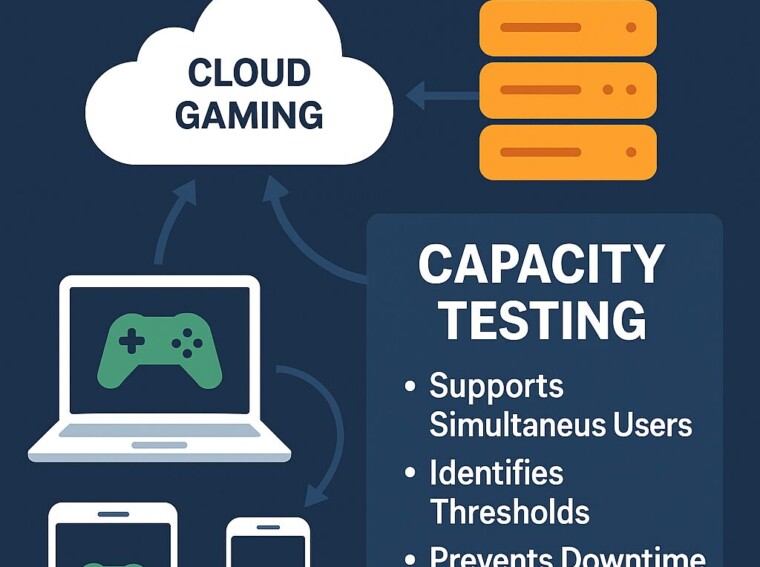Cloud gaming is no longer a futuristic concept; it’s here, portable, and changing how gamers play worldwide. Services like GeForce Now, Xbox Cloud Gaming, and PlayStation Remote Play enable players to access their favorite titles on laptops, tablets, and even smartphones, transforming any device into a portable gaming machine. However, behind this innovation lies a critical question: can the servers handle the load? This is where capacity testing comes into play.
Capacity testing ensures that cloud gaming platforms can support thousands of simultaneous users without buckling under pressure. It identifies thresholds, prevents downtime, and safeguards the smooth gameplay that portable gamers demand. Without it, even the most advanced service could falter during peak hours, frustrating players and damaging trust in the platform. In essence, capacity testing isn’t just a behind-the-scenes quality check; it’s the backbone of delivering a reliable gaming experience across devices and networks.
In this article, we’ll explore the importance of capacity testing for cloud gaming platforms, how it impacts the portable gaming experience, and why both developers and players should care.
What is Capacity Testing?
Capacity testing is a type of performance testing that determines how many users, transactions, or workloads a system can handle before reaching a breaking point. In gaming, this means testing how many concurrent users can stream games before the service slows down, crashes, or compromises the experience.
To dive deeper into the fundamentals, you can explore the capacity testing with testRigor article, which provides a structured approach to implementing capacity testing in software systems.
For cloud gaming, capacity testing ensures that when thousands; or even millions; log in to play at the same time, the service remains smooth, reliable, and lag-free. This is critical because gamers have little patience for buffering, lag, or connection drops. A poorly tested platform risks losing customers quickly, especially in a competitive market where alternatives are only a few taps away.
Capacity testing also helps identify scaling thresholds, showing exactly when additional server resources are required to meet demand. By simulating real-world usage conditions, developers gain insight into both software and infrastructure limitations. This not only improves user experience but also optimizes cost efficiency, as companies avoid over-provisioning servers while still ensuring stability. In short, capacity testing is the bridge between seamless gameplay and the technical realities of resource management.
The Rise of Portable Cloud Gaming
Portable gaming has always been about accessibility. First came handheld consoles like the Game Boy and PSP, then smartphones, and now cloud streaming. Players expect high-end titles to run seamlessly across devices, whether they’re on a high-speed home network or mobile data.
Unlike traditional games that rely on device hardware, cloud gaming depends on servers to handle the heavy processing and stream gameplay to devices. If those servers can’t scale to meet demand, players experience:
- Input lag
- Frame rate drops
- Connection timeouts
- Session disconnects
This makes capacity testing vital to guaranteeing consistent service for portable gamers. The challenge is even greater because portable players often connect from varied environments; sometimes using 5G networks on the move, other times relying on public Wi-Fi with fluctuating speeds. These unpredictable conditions magnify the importance of server stability.
As cloud platforms compete to deliver console-quality graphics anywhere, capacity testing ensures that the promise of portability doesn’t collapse under real-world pressure. By simulating heavy user loads and diverse network scenarios, companies can better prepare their systems for peak demand, seasonal surges, and sudden spikes caused by blockbuster releases. Without this, the dream of seamless portable cloud gaming could quickly turn into a frustrating experience.
Why Server Capacity Is a Bottleneck
Cloud gaming relies on vast data centers with powerful GPUs and network infrastructure. Yet, even the best hardware has limitations. When demand exceeds server capacity, the system can’t allocate enough resources per user, leading to degraded experiences.
For example:
- GeForce Now uses virtualized GPUs to deliver high-quality graphics. Without capacity testing, NVIDIA risks overcrowding servers, resulting in downgraded video quality for users.
- Xbox Cloud Gaming integrates with Xbox Game Pass. If Microsoft doesn’t test its capacity, peak usage during big releases (like Starfield) could overwhelm the system.
Server limitations aren’t just about hardware. Network throughput, data center routing, and load balancing all come into play. Capacity testing reveals these weak points before players suffer. It also highlights how systems behave under stress, showing whether failures occur gradually or abruptly. This knowledge allows providers to design failover strategies and implement auto-scaling solutions, ensuring players experience smooth, uninterrupted gameplay even when demand unexpectedly spikes.
Portable Gaming and User Expectations
Portable gamers often play in short bursts; on commutes, breaks, or while traveling. This means reliability is key. If a cloud gaming service crashes or stutters, players may abandon it entirely.
Capacity testing ensures that even under unpredictable spikes; such as a new title release, a holiday season, or a global tournament; cloud gaming services maintain stability. This reliability keeps users engaged and subscribed, directly impacting business success. Beyond technical performance, it also builds trust and loyalty. Gamers want confidence that the service will work whenever and wherever they log in. A single poor experience can push users toward competing platforms, especially in a crowded market. By meeting these heightened expectations, capacity testing not only safeguards the user experience but also strengthens a platform’s reputation as dependable and future-ready.
Capacity Testing in Real-World Scenarios
Let’s consider some practical situations where capacity testing plays a role:
- Game Launch Events
When a AAA game drops on Xbox Cloud Gaming, millions rush in on day one. Capacity testing simulates this rush to confirm the platform can handle demand. Without it, players could face long wait times, stuttering visuals, or even server crashes during the most critical launch window. Since player sentiment is heavily shaped in the first days of release, a smooth experience can make or break both the game and the platform’s reputation.
- Cross-Platform Multiplayer
Portable gamers expect to join console and PC friends seamlessly. Without capacity testing, matchmaking servers could crash under load, disrupting the competitive ecosystem. For esports and live tournaments, even a few seconds of downtime can ruin a match and erode player trust. Capacity testing ensures fair matchmaking, consistent performance, and uninterrupted gameplay across different device types.
- Regional Expansions
When cloud gaming services launch in new countries, they must handle unknown usage patterns. Capacity testing prepares systems for unexpected spikes. For example, a region with high mobile penetration but limited infrastructure may stress servers differently than North America or Europe. By simulating these scenarios, providers can fine-tune resource allocation, avoid downtime, and deliver consistent quality to new audiences
Ultimately, capacity testing is about anticipating stress points before users encounter them. It transforms uncertainty into predictable, manageable outcomes, giving developers and operators confidence in scaling globally.

Balancing Cost and Performance
While scaling up servers seems like the easy solution, it’s not economically sustainable. Capacity testing helps companies strike a balance by identifying:
- Optimal server provisioning (how many servers are actually needed)
- Resource allocation strategies (how to share GPU/CPU among users)
- Threshold alerts (when to auto-scale servers before overload occurs)
This ensures cloud gaming platforms deliver a stable experience without overspending on unused infrastructure. It also provides insight into long-term trends, allowing companies to forecast demand with greater accuracy. Instead of reacting to sudden spikes, businesses can proactively prepare and fine-tune resources. This not only saves money but also creates a scalable, predictable model for growth, ensuring cloud gaming remains profitable while still meeting user expectations.
The Role of Automation in Capacity Testing
Manual testing won’t cut it for something as complex as cloud gaming. Automated testing frameworks are essential to simulate thousands of concurrent users and measure system performance.
Advanced QA teams are now integrating AI into their testing processes. If you’re interested in adopting AI-powered approaches for testing, it’s worth looking at these free AI testing tools that can complement traditional load and capacity testing.
The Future of Capacity Testing in Portable Cloud Gaming
As cloud gaming grows, so do the demands on capacity testing. Emerging technologies like 5G networks, AI-driven server management, and edge computing are changing the landscape.
- 5G reduces latency, but servers must be ready to handle faster and larger data flows.
- AI can predict and prevent capacity issues by learning user patterns.
- Edge computing reduces server strain by moving some processing closer to the user.
Capacity testing will evolve to account for these technologies, ensuring that portable gaming remains smooth and accessible anywhere.
Final Thoughts
Portable cloud gaming is redefining how and where we play, but its success depends on more than powerful servers and fast networks. Without proper capacity testing, even the best services risk frustrating users with lag, crashes, and downtime.
By investing in robust capacity testing strategies, platforms like GeForce Now and Xbox Cloud Gaming can deliver the seamless, reliable experiences that portable gamers expect; whether they’re at home, commuting, or halfway across the world.

